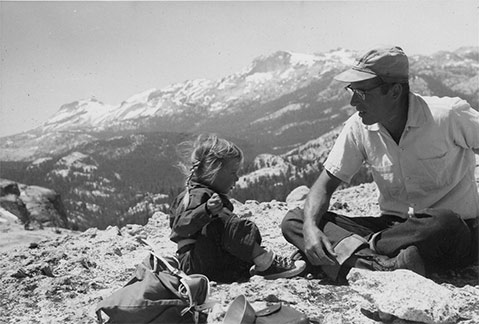
Frederick Eissler, mountaineer, teacher, and dedicated environmental activist, died on May 8, 2014, at the age of 91. He is survived by his wife, Anne, and daughter Margaret and was preceded in death by his daughter Christine.
Fred was one of my heroes. He took seriously his responsibilities as a citizen, teaching by example how to exercise the rights we all possess to meet our civic and ecological obligations. I never met a person who accomplished more to further the public conservation and environmental agenda during the several decades in which he was active. The powerful interests who made the mistake of underestimating his determination and effectiveness learned some hard lessons at his wonderfully capable hands. He was widely and deeply admired by his colleagues and allies as one of the most focused, fearless, and far-sighted among us.
Born in 1922 in Philadelphia, Pennsylvania, Fred attended Friends’ Central School and then University of North Carolina at Chapel Hill, where he received a BA in English. He met Anne Parker in 1952 at the Sierra Club’s Clair Tappaan Lodge on Donner Summit. They were snowed in together during the Storm of 1952 and married later that year. They had two daughters, Margaret and Christine. Fred received a teaching credential at San Jose State and first taught grades 1-8 in a one-room school at June Lake, where he was also the janitor and bus driver, and then a school in Santa Rosa before moving to Santa Barbara. He taught two years at Jefferson Elementary School and 25 years at San Marcos High School.
In the summers of 1956-1961, Fred and Anne were caretakers for the Sierra Club campground on the Soda Springs property in Tuolumne Meadows at Yosemite National Park. During this time, he initiated and led the first Sierra Club service trips with the intent to change the national wilderness litter policy to “pack out all that you packed in.” After a six-year campaign, he succeeded. Fred immersed himself in the Sierra Nevada and Santa Barbara’s backcountry every chance he got.
From 1963-1969, Fred served as a member of the national board of directors of the Sierra Club, where he and the group’s executive director, David Brower, advocated a transition to an even more activist, ecologically informed, internationally inclined “environmentalist” organization, a direction opposed at that time by a majority of more traditionally “conservation-minded” directors. When the Sierra Club split over the building of a nuclear power plant at Diablo Canyon, Fred turned his exceptional talents to a remarkably wide array of environmental issues as director of the Santa Barbara–based public-interest nonprofit group Scenic Shoreline Preservation Conference, which he founded in 1967 along with ecologist Garrett Hardin, environmental historian Rod Nash, and others. Over the next 40 years, Fred worked in alliance with a long list of environmental leaders and groups in Santa Barbara and elsewhere in California and the country. He was a master practitioner within the adversarial processes of the American legal and administrative decision-making systems, and without formal legal education, he routinely saw through, outworked, and outflanked far more powerful corporations and governmental agencies and their teams of lawyers and specialists.
Fred’s passion for and commitment to place led him to work tirelessly on behalf of the Sierra Nevada and Santa Ynez Mountains; national forests and other public lands throughout California; Diablo Canyon, the Gaviota Coast, and other coastal wildlands; the Channel Islands National Park and the Channel Islands Marine Sanctuary; More Mesa; the Santa Barbara waterfront; and many other urban parks and open spaces. He made sure agencies responsible for preserving and protecting these places performed their duties in accordance with the best available scientific evidence, long-term planning tools, and the highest regard for the long-term public interest.
For Fred, his efforts brought their own rich rewards. He was strong, centered, and indefatigable in the face of disappointment and loss, gracious and humble in success. He would always turn immediately to the next issue. Fred did not seek recognition, and we got along best when I could put the lid on my great admiration for him.
When friends and colleagues tried to honor Fred for the work that he, Jim Mills, Robert O. Easton, and a few others did in getting Congress to create the San Rafael Wilderness Area — a groundbreaking achievement of national significance — Fred politely but firmly declined to show up for the accolades. When the Diablo Canyon nuclear power plant was infamously approved in the face of evidence produced by him of disqualifying seismic hazards, Fred shook it off and contributed mightily to the successful effort to defeat a plan to place an LNG terminal on the coast near Point Conception. When officials of the California Department of Transportation (Caltrans) tried to build an elevated stretch of Highway 101 through the heart of Santa Barbara, Fred rallied community awareness and opposition to persuade state officials to abandon the project.
And when you go to Chase Palm Park, that beautiful stretch of open space along the Santa Barbara waterfront to the east of Stearns Wharf, you might say a word of thanks to Fred, who worked to preserve it for the enjoyment of future generations. He loved the place, and he fought for it, and here and in so many places in California and beyond, his love and his work live on.
